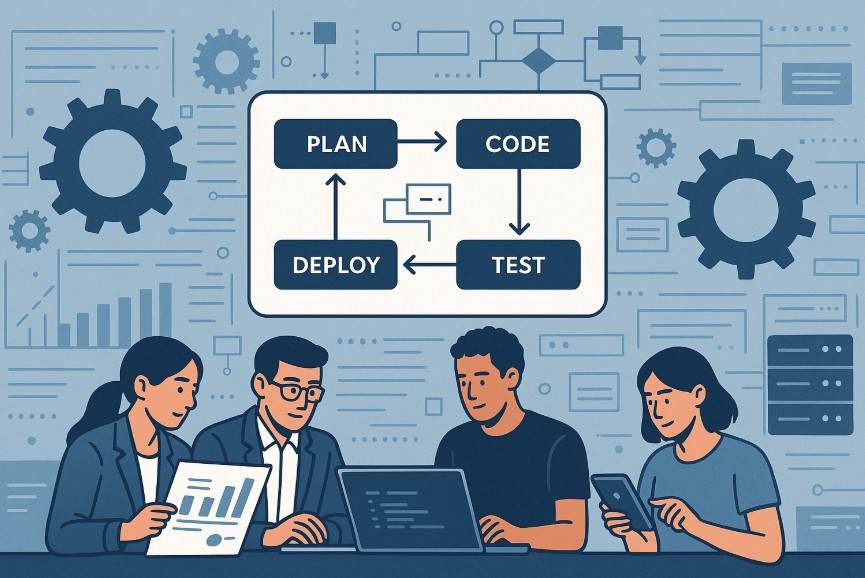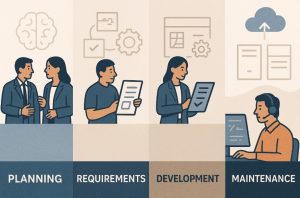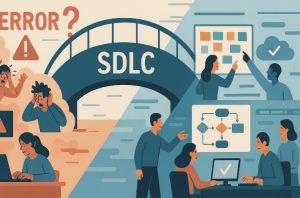
How do software teams consistently deliver applications that are reliable, secure, and aligned with business goals? The answer lies in the use of a structured methodology called the Software Development Life Cycle (SDLC).
This lifecycle provides a systematic approach to software creation, ensuring quality, predictability, and stakeholder satisfaction from concept to deployment.
What Does the Software Development Life Cycle Mean?

The Software Development Life Cycle (SDLC) is a structured, step-by-step process used by development teams to design, build, test, and maintain software systems.
It defines the stages and deliverables required to transform a business idea into a fully functioning software application, making it the foundation of any effective software development service. SDLC serves as a project management framework in software engineering, guiding teams through each critical phase of development.
By breaking down the software development journey into manageable segments such as planning, designing, coding, testing, and maintenance, SDLC ensures greater control, improved quality, and predictable outcomes.
This methodology not only reduces risks and development costs but also enhances communication among stakeholders, helping businesses deliver software that meets user expectations and performs reliably in real-world environments.
How Is SDLC Defined in Software Engineering?
In software engineering, SDLC refers to a set of well-defined phases that guide the development team through the lifecycle of a software project. It acts as a blueprint that determines how an information system is planned, implemented, and maintained.
The goal of SDLC is not merely to complete a software project, but to do so with precision, efficiency, and quality. Each phase includes specific deliverables and review points, making the process more manageable and measurable.
What Is the Main Purpose of the Software Development Life Cycle?
The primary objective of SDLC is to provide a structured approach to software creation that ensures:
- Fulfilment of user requirements
- Delivery within budget and on time
- High levels of software quality and maintainability
- Predictable and manageable workflows
By using SDLC, development teams are better equipped to handle complexity, adapt to change, and achieve consistent results across projects.
What Are the Main Phases of the Software Development Life Cycle?

Although different organisations may adapt the SDLC to their specific needs, the typical SDLC process consists of the following six to seven stages:
What Happens During Planning and Requirement Analysis?
The planning and requirement analysis phase is the foundation of the software development life cycle. It begins with a deep understanding of what the software must achieve, who the users are, and how the software fits into the broader organisational context.
Project managers and business analysts engage with stakeholders to gather detailed requirements. This often includes feasibility studies, budgeting, resource planning, risk assessments, and the preparation of the Software Requirements Specification (SRS) document.
This document becomes a reference point throughout the development cycle and ensures that the team’s work aligns with business goals.
What Is Involved in Defining Requirements?
This phase involves formalising and validating all software requirements. The focus is on functional requirements (what the software should do) and non-functional requirements (how the software performs under various conditions).
The SRS document, produced during this phase, includes:
- Functional specifications
- Interface and integration requirements
- Security, performance, and compliance needs
Approval from stakeholders at this stage is crucial as it determines the scope and boundaries of the project.
How Is System Design and Architecture Created?
Once the requirements are clear, the next step is designing the system architecture. The design phase involves two components: high-level design (HLD) and low-level design (LLD).
- High-Level Design (HLD): Outlines system architecture, technology stack, data models, and user interface layouts.
- Low-Level Design (LLD): Provides detailed descriptions of logic, algorithms, APIs, and database schema.
All designs are documented in the Design Document Specification (DDS), which is reviewed by stakeholders before development begins.
What Takes Place in the Development Phase?
During the development phase, the actual building of the software product occurs. Developers write code in accordance with the specifications outlined in the DDS and SRS.
The selection of programming languages, frameworks, and tools depends on the nature of the application. Popular choices include:
- Java for enterprise applications
- Python for web-based or AI-driven systems
- C/C++ for system-level software
Version control systems, integrated development environments (IDEs), and CI/CD pipelines are used to improve development efficiency and code quality.
Why Is Testing Essential in SDLC?
Testing is a critical stage in the SDLC and cannot be confined to a single phase. Ideally, testing starts early and continues throughout the development process. This approach is referred to as continuous testing.
Testing types include:
- Unit testing
- Integration testing
- System testing
- Acceptance testing
- Security and performance testing
The goal is to ensure the product is free from critical defects, meets performance criteria, and satisfies all outlined requirements.
How Is Deployment and Maintenance Managed?
Deployment is the process of releasing the software into the production environment. It includes tasks such as configuring servers, setting up databases, and preparing deployment pipelines.
Deployment can be:
- Staged: where a beta release is tested by a limited user group
- Full release: where the entire user base gets access
After deployment, the maintenance phase begins, which includes:
- Fixing bugs
- Providing updates
- Addressing new user requirements
- Monitoring performance and usage
Table: Overview of SDLC Phases and Their Deliverables
| Phase | Key Activities | Deliverables |
| Planning & Analysis | Requirement gathering, feasibility study | Project plan, SRS |
| Requirements Definition | Functional & non-functional requirements specified | Approved SRS |
| Design | Architecture and design modelling | DDS (Design Document Specification) |
| Development | Coding, integration, and version control | Source code, builds |
| Testing | Functional, performance, and security testing | Test cases, bug reports |
| Deployment | Production setup and release | Release notes, deployment scripts |
| Maintenance | Updates, bug fixes, user support | Patch logs, issue tracking reports |
What Are the Most Common SDLC Models and Methodologies?
The SDLC process can be implemented using different models. The choice of model affects how the stages are organised and executed.
Table: Comparison of Popular SDLC Models
| SDLC Model | Characteristics | Suitable For |
| Waterfall | Linear, sequential, no backward movement | Small, well-defined projects |
| Agile | Iterative, incremental, highly flexible | Projects with evolving requirements |
| Iterative | Cyclical development, frequent releases | Large projects with growing scope |
| Spiral | Risk-driven, combines iterative and waterfall models | High-risk, mission-critical systems |
| V-Model | Verification and validation steps added to each phase | Safety-critical applications |
| Big Bang | Informal, no planning, all resources used simultaneously | Experimental or tiny projects |
Each model has strengths and weaknesses, and choosing the right one depends on the nature of the project, stakeholder expectations, and available resources.
What Are the Key Benefits of Using the Software Development Life Cycle?

Implementing a well-defined SDLC offers numerous advantages:
- Project Visibility and Transparency: Stakeholders can track progress at every stage.
- Improved Quality: Structured testing ensures fewer bugs and higher stability.
- Risk Management: Early planning reduces uncertainty and potential failures.
- Cost Efficiency: Clear deliverables and documentation prevent scope creep.
- Enhanced Collaboration: Defined roles and responsibilities promote teamwork.
How Is the Software Development Life Cycle Different from the Software Development Process?
The Software Development Life Cycle (SDLC) refers to the strategic and structured methodology behind software creation. In contrast, the software development process is the practical execution of these stages using tools, teams, and techniques.
SDLC provides the “what” and “when,” while the software development process focuses on the “how.”
What Challenges Do Organisations Face When Using the SDLC?
While SDLC brings structure, it is not without challenges:
- Rigid models (like Waterfall) are unsuitable for projects with changing requirements.
- Inadequate stakeholder involvement can lead to misaligned goals.
- Poor requirement gathering results in software that does not meet user expectations.
- Security concerns often arise when testing is postponed until the later stages.
To overcome these, modern practices like Agile, DevOps, and DevSecOps integrate flexibility, automation, and security throughout the cycle.
What Are the Best Practices for Implementing SDLC Successfully?
- Involve all stakeholders early and frequently.
- Maintain clear and comprehensive documentation.
- Choose the SDLC model that fits the project’s size, complexity, and risk level.
- Automate testing and deployment where possible.
- Use metrics to monitor performance and identify improvements.
Why Should Every Project Use a Software Development Life Cycle?

Every software project involves complexity, change, and risk. SDLC acts as a guiding framework that breaks down development into manageable parts. It ensures consistency, accountability, and a higher chance of delivering software that meets both business goals and user needs.
Projects without SDLC often suffer from unclear requirements, miscommunication, and failure to meet timelines and budgets.
Real-Life Example: SDLC in a Banking Application
To understand SDLC in action, consider a banking app:
- Planning: Business analysts meet with stakeholders to collect requirements such as account access, transaction features, and security.
- Design: Developers and designers work on architecture and UI mock-ups.
- Development: The team codes APIs, interfaces, and integrates backend services.
- Testing: QA conducts functionality, security, and performance tests.
- Deployment: The app is deployed in phases, starting with internal users.
- Maintenance: Continuous updates and new features are added as per user feedback.
Frequently Asked Questions
Why is SDLC essential in modern software development?
It provides a standardised process for creating reliable, efficient, and scalable software, reducing waste and improving quality.
How does SDLC incorporate security?
Through DevSecOps, security is integrated into every SDLC stage rather than being an afterthought.
Which SDLC model should startups use?
Startups often benefit from Agile or Lean models due to their speed, adaptability, and customer-focused approach.
How does SDLC minimise project risk?
By encouraging early planning, regular reviews, and stakeholder involvement, SDLC helps identify and mitigate risks early.
What tools support SDLC implementation?
Common tools include Jira, Git, Jenkins, AWS CodePipeline, and CodeBuild, depending on the project needs.
Is SDLC used only for large projects?
No. SDLC can be scaled down for small projects as well. Even minimal projects benefit from structure and planning.
Can SDLC be customised?
Yes. Many organisations use hybrid models that combine features of Agile, Waterfall, and DevOps to match their unique needs.